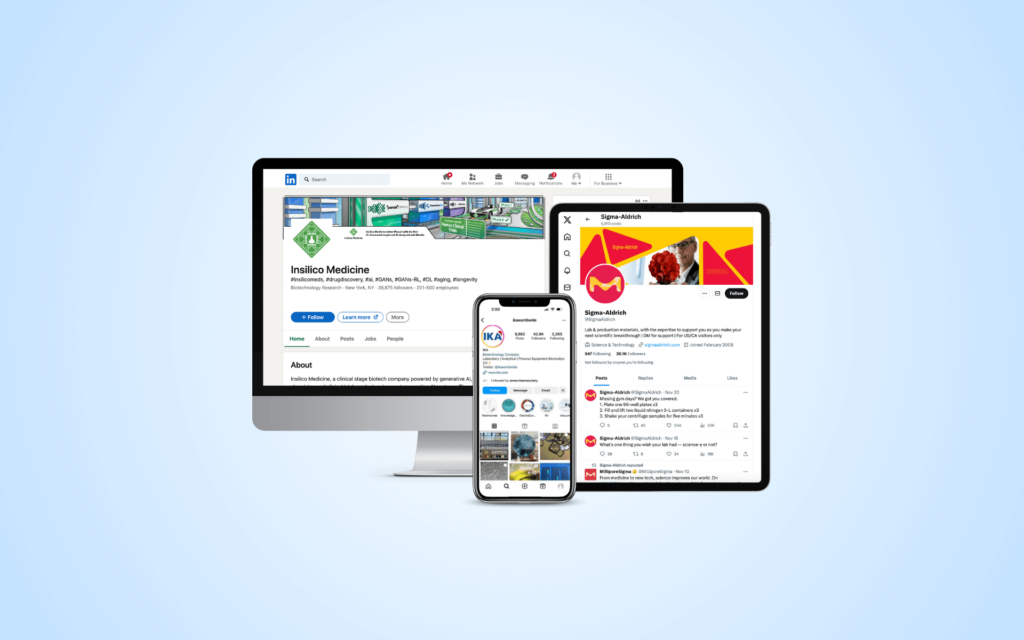When it comes to digital marketing in the science industry, social media can be a key component to building and maintaining your brand.
To gain and retain customers and followers, staying on top of today’s latest trends is crucial. Producing themed posts for specific days of the week, coming up with creative ways to showcase your company and products, and leveraging sponsorships and collaborations with others, are just a few ways to ramp up your social media presence.
Read below to find out which companies are leading the way when it comes to their social media content and tactics in the science space.
Sigma-Aldrich – Engaging your Social Media Audience on X (Twitter)
Sigma-Aldrich is easily one of the best science brands on X (formerly Twitter). They have used a combination of humor and geeky science posts to generate a substantial following.
One of Sigma-Aldrich’s strengths is the comments. Many corporate accounts on X are “set it and forget it,” where posts are scheduled in advance, and there is little active usage. Sigma-Aldrich shows there is a lot of value from more direct engagement.
Perhaps what is most impressive about their work is how these posts tie back to the Sigma-Aldrich brand without being too pushy. An example is the “assorted chocolates” giveaways, which are packaged in a white bottle with a red cap.
This same bottle is used to store many of the chemicals Sigma-Aldrich sells. They are all over many chemistry and biology labs, but scientists may not recognize them as Sigma-Aldrich containers. These contests remind scientists about Sigma-Aldrich’s role in their everyday research by drawing attention to these bottles.
Insilico Medicine – Thought Leadership Synergy on LinkedIn
Insilico Medicine has 39,000 followers on LinkedIn but only about 240 employees. That ratio – over 100 followers per employee – is exceptional. How can a company so small have such an enormous impact?
Looking at the posts, it is clear this profile isn’t just a bulletin board for sharing the latest company press release. They regularly write detailed posts on complex scientific topics such as AI in drug discovery, offering real value to readers trying to keep up with the latest developments in these fast-moving fields. It helps that Insilico Medicine’s specialty is trendy at the moment, but someone still has to put in the effort to write thoughtful posts multiple times per week.

But to fully understand their success, you need to look beyond Insilico’s company page. You also need to look at founder and CEO Alex Zhavoronkov’s more than 40,000 followers! How did he do that? He posts regularly, discussing AI, medicine, and technology more generally. There is no trick, just putting in the time while offering an interesting perspective and relevant expertise.
The synergy between these two accounts is also executed well. Some company profiles can feel like a fan page for a company’s founder, where every post links to their latest podcast appearance or interview. Insilico Medicine and Alex do reshare each other’s posts, but not so often that it feels uncomfortable.
IKA – Sharing the Beauty of Chemistry
Of course, there are a lot of companies that don’t work in trendy fields like AI drug discovery. Can social media help science companies that aren’t focused on thought leadership?
IKA sells stir plates, heating mantles, pipettes, and other everyday laboratory equipment. The company has been around for over 100 years but is smaller than many of its competitors. One of the tools they use to level up their impact is their Instagram account, where they have racked up over 42,000 followers.

Their almost 10,000 posts are mostly reshares of beautiful or unusual-looking chemistry-related pictures and videos. It is a seemingly endless stream of glowing fluorescent liquids, pink crystals, kaleidoscopic silica columns, and more. IKA’s Instagram account is an excellent example of how a small company selling commoditized products can use social media to raise brand awareness.

Collaborating with Influencers: Biohaven Pharmaceuticals
According to Start Up Bonsai, 80% of consumers have bought a product as the result of a recommendation from an influencer. Collaborating with well-known experts and public figures is an excellent way to increase brand awareness and tap into a broader audience. One example: Biohaven Pharmaceuticals, a clinical-stage biopharmaceutical company that targets neurological diseases and disorders, recently partnered with OCD Doodles.

The popular social media account is run by OCD advocate and scientist Dr. Laura Johnson who was diagnosed with obsessive-compulsive disorder (OCD) at the age of 29. Dr. Johnson took over the company’s Instagram feed for OCD awareness week and shared about her life as an OCD advocate and method for creating awareness.
For more #inspo take a look at Biohaven Pharmaceuticals’ Instagram.
Getting Creative: Luminex and GlaxoSmithKline
Who says science can’t be fun? Science can be complicated, and the learning and understanding of some information may be overwhelming for followers that aren’t as immersed or familiar in the subject.
Biotech company, Luminex decided to have a little fun with their marketing and produced a parody video showcasing their xMAP® technology. Although Luminex’s xMAP® Technology is a rather complex subject, summing up the idea of the product using various well-known songs not only adds a fun twist to learning but creates more of a lasting impression.

In 2021, as the world adjusted to virtual meetings and interviews, global healthcare company GlaxoSmithKline seized the opportunity and poured their creativity into a video series called Science on the Sofa. This series combines conversations on healthcare and science with experts and patients, all from the comfort of their own home. While it can’t replace in-person connection, finding ways to interact with industry peers at a time of social distancing was a great way to keep the conversations going.
For more #inspo, check out the Luminex and GSK LinkedIn accounts.
Recurring Content: DeviceTalks
Just as the saying goes, consistency is key. Promoting a recurring theme on your company’s social media platforms can help drive consistent visits to your social channels.
Medtech and medical device industry publication DeviceTalks, produces a weekly series called DeviceTalks Tuesdays, that features discussions and workshops for those interested in the Medtech industry. Having a stream of recurring content is an ideal strategy that can create buzz and anticipation for upcoming events. This series entices followers of DeviceTalks to not only participate in industry conversations, but to keep coming back for more content as it’s delivered once a week.
For more #inspo check out DeviceTalks’ X/Twitter.
Amplifying Diversity, Equality, and Inclusion: GE Healthcare and 3M
Being able to connect and engage with your audience in a way that is real, relatable, and inclusive shows authenticity and an overall commitment to supporting more than just what your company is promoting or selling.
When it comes to issues within our society it’s important for companies to use their voice and speak up in situations where their consumers’ and employees’ lives are impacted.
In 2020, GE Healthcare produced a video interview series on YouTube, spotlighting the Black Lives Matter movement featuring various GE employees and their personal perspectives and experiences. During the month of June, they also highlighted and shared LGBTQ employee stories in celebration of Pride Month.

Similarly, for Asian American and Pacific Islander (AAPI) Heritage Month, 3M produced short videos highlighting AAPI employees and their stories on Twitter. They also created the video series Not The Science Type, that was shared across social platforms highlighting in-depth discussions with women surrounding different stereotypes and the impact they have when it comes to diversity, equity & inclusion in STEM.
These various initiatives and programs also show support for GE Healthcare’s and 3M’s employees, allowing for them to feel seen, respected, and valued within the company.
For more #inspo visit GE Healthcare’s LinkedIn and 3M’s Twitter.
Using Hashtags to Categorize Content: GlaxoSmithKline
According to Pew Research Center, about half of Americans consumed their news via social media platforms. With the amount of information being generated and published every second, it’s imperative that tactics are used to ensure your company’s information is targeting the right audiences. Hashtags are a unique addition to social media marketing, enabling companies to increase their digital footprint across multiple social media platforms.
According to Sticky Leads, a study done by Twitter revealed that the use of hashtags can increase audience engagement by 50%. GlaxoSmithKline is a prime example of how to leverage this simple strategy. In order to specifically target investors and the media, GSK’s use of the hashtags #investors and #media when disseminating information across their platforms creates buckets for their content, in turn making the information more accessible for those actively searching for these specific subjects.

For more #inspo visit GSK’s LinkedIn account.
In the end, there are countless ways to ramp up your company’s social media presence. Keep in mind that responding to comments, tags, and digital conversations is equally crucial for gaining and maintaining a following Don’t be afraid to be creative and try new and fresh ideas. Different content works for different companies, and once you find what works for yours the possibilities are endless.


















